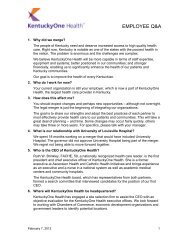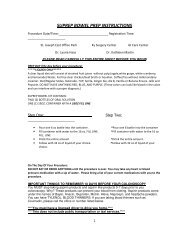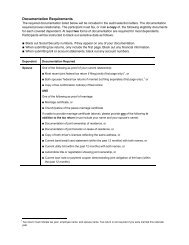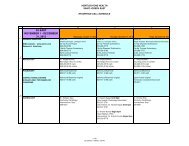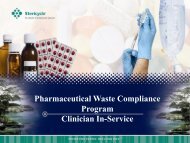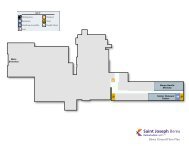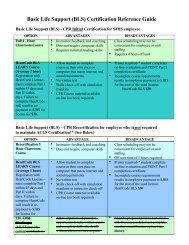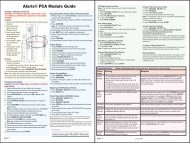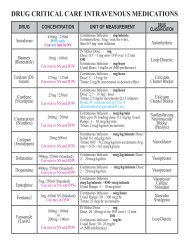Tips on Accessing, Assessing and Maintaining Implanted Ports with ...
Tips on Accessing, Assessing and Maintaining Implanted Ports with ...
Tips on Accessing, Assessing and Maintaining Implanted Ports with ...
You also want an ePaper? Increase the reach of your titles
YUMPU automatically turns print PDFs into web optimized ePapers that Google loves.
<str<strong>on</strong>g>Tips</str<strong>on</strong>g> <strong>on</strong> <strong>Accessing</strong>, <strong>Assessing</strong> <strong>and</strong> <strong>Maintaining</strong><br />
<strong>Implanted</strong> <strong>Ports</strong> <strong>with</strong> N<strong>on</strong>-Coring Huber Safety Needle<br />
Reference – 6 ONC – ext 4660<br />
Check <strong>with</strong> Patient to see if they have any<br />
informati<strong>on</strong> <strong>on</strong> their Port: a Bard Port (round) or a<br />
Power Port (triangular).<br />
Order from: Central Distributi<strong>on</strong> (1940 – SJH, 5304 – SJE req specific<br />
needle) or Par Excellence:<br />
• Mini Loc Huber – Regular or double Port-a-Caths<br />
• Power Loc Huber Needle – for Power<strong>Ports</strong><br />
Must be used if needed for CT Scans<br />
Miniloc <strong>and</strong> PowerLoc Huber needle lengths: ¾ inch, 1 inch <strong>and</strong> 1 ½<br />
inch<br />
• 1 inch is most comm<strong>on</strong>ly used length<br />
• ¾ inch for a patient <strong>with</strong> a very thin walled chest<br />
• 1 ½ inch is for patient <strong>with</strong> large chest wall where the port sits<br />
deep in the chest.<br />
• USE SMALLEST NEEDLE POSSIBLE<br />
THAT CAN DELIVER PRESCRIBED<br />
THERAPY YET TOUCHES THE BOTTOM<br />
OF THE PORT<br />
•<br />
Prepare Huber needle by attaching a CLC2000<br />
to tubing <strong>and</strong> flush tubing <strong>and</strong> needle <strong>with</strong> an attached<br />
prefilled NS Syringe keeping needle sterile.<br />
Open Chloraprep <strong>and</strong> d<strong>on</strong> sterile gloves<br />
Palpate port site <strong>and</strong> locate septum – Power<strong>Ports</strong> are triangular <strong>with</strong> three<br />
palpable bumps <strong>on</strong> each corner, Regular ports are round <strong>and</strong> may be a<br />
double port.<br />
<str<strong>on</strong>g>Tips</str<strong>on</strong>g> <strong>on</strong> <strong>Accessing</strong>, <strong>Assessing</strong> <strong>and</strong> <strong>Maintaining</strong><br />
<strong>Implanted</strong> <strong>Ports</strong> <strong>with</strong> N<strong>on</strong>-Coring Huber Safety Needle<br />
Cleanse the site <strong>with</strong> Chlora Prep for 30 sec<strong>on</strong>ds using a back <strong>and</strong> forth<br />
moti<strong>on</strong>.<br />
Relocate port by palpati<strong>on</strong> <strong>and</strong> immobilizati<strong>on</strong><br />
<strong>with</strong> your n<strong>on</strong>dominant h<strong>and</strong>.<br />
Insert the huber needle: Grasp colored wings of<br />
the miniloc or Power Loc needle <strong>and</strong> needle <strong>with</strong><br />
syringe <strong>with</strong> syringe attached, perpendicular to<br />
the septum <strong>and</strong> push firmly through the skin until<br />
needle c<strong>on</strong>tacts back of port.<br />
Biopatch applied blue side up <strong>with</strong> Bioclusive dsg applied<br />
(2X2 gauze if bleeding), label <strong>with</strong> date <strong>and</strong> initials.<br />
PowerPort: apply purple label to Power Loc tubing.<br />
Document: Nurse’s Notes/MAR<br />
Aspirate for Blood<br />
return c<strong>on</strong>firms<br />
placement then Flush<br />
<strong>with</strong> 10ml NS.<br />
Remove syringe<br />
then clamp. Attach<br />
a CLC 2000 or IV<br />
tubing.<br />
Change needle, biopatch <strong>and</strong> CLC2000 q7days or earlier if wet or loose.<br />
New port dsg are to be changed in 24h if gauze used. If allergic to biopatch<br />
<strong>and</strong> <strong>on</strong>ly sorbaview or tegaderm is used change q3day.<br />
Flush Accessed port lines q8hrs <strong>with</strong> 10ml NS.<br />
After Blood, Blood Draws, <strong>and</strong> TPN use 20ml NS.<br />
Assess each shift – ensure that CLC2000 is <strong>on</strong> the end of Huber <strong>and</strong><br />
not indented.<br />
page 1 page 2
•<br />
•<br />
•<br />
•<br />
•<br />
•<br />
•<br />
•<br />
•<br />
<str<strong>on</strong>g>Tips</str<strong>on</strong>g> <strong>on</strong> <strong>Accessing</strong>, <strong>Assessing</strong> <strong>and</strong> <strong>Maintaining</strong><br />
<strong>Implanted</strong> <strong>Ports</strong> <strong>with</strong> N<strong>on</strong>-Coring Huber Safety Needle<br />
Deaccessing the Portacath Needle<br />
(MiniLoc Huber Needle)<br />
Flush port <strong>with</strong> 10 ml of NS then 500 units Heparin (5ml of<br />
100units/ml).<br />
Take off syringe, close clamp. Flush 2nd port if present<br />
Clean h<strong>and</strong>s <strong>and</strong> d<strong>on</strong> gloves<br />
Remove old dressing<br />
D<strong>on</strong> Sterile Gloves<br />
Stabilize the port by securely holding the finger tabs down<br />
<strong>and</strong> firmly pull the wings up until you hear or feel the click<br />
<strong>and</strong> visualize an orange dot. Dispose in a sharps c<strong>on</strong>tainer.<br />
Apply pressure if site bleeds<br />
Apply 2x2 or b<strong>and</strong>aid<br />
Document in NN <strong>and</strong> Note Heparin flush <strong>on</strong> MAR<br />
Routine Maintenance of Deaccessed Portacath<br />
Flush device <strong>with</strong> 500 units (5ml of 100 units/ml) q4weeks<br />
Flushing Central Lines, PICCS, Portacaths<br />
PICCS, Power PICCS, deep lines, accessed ports that do not<br />
have fluid c<strong>on</strong>tinuously infusing are to be flushed q8hrs <strong>with</strong><br />
5-10ml of NS<br />
All Central line lumens will have CLC2000 Positive pressure<br />
adapters attached to them<br />
CLC2000 can remain <strong>on</strong> for 7days – document changes<br />
Ensure these are not indented<br />
<str<strong>on</strong>g>Tips</str<strong>on</strong>g> <strong>on</strong> <strong>Accessing</strong>, <strong>Assessing</strong> <strong>and</strong> <strong>Maintaining</strong><br />
<strong>Implanted</strong> <strong>Ports</strong> <strong>with</strong> N<strong>on</strong>-Coring Huber Safety Needle<br />
Checklist for Identifying <strong>and</strong> <strong>Accessing</strong> the<br />
PowerPort <strong>Implanted</strong> Port for C<strong>on</strong>trast Injecti<strong>on</strong><br />
1. C<strong>on</strong>firm the presence of a Power Port Device<br />
•<br />
•<br />
•<br />
•<br />
Check Patient’s Chart for Device Identificati<strong>on</strong> Sticker<br />
– new placement<br />
Palpate the Port of Triangular Shape<br />
Palpate Port for Three Palpati<strong>on</strong> Points<br />
Ask the Patient for PowerPort device ID or<br />
other Identifying Items<br />
2. Access the port, c<strong>on</strong>firm blood return <strong>and</strong> flush<br />
•<br />
•<br />
•<br />
Access <strong>with</strong> Power Loc* Huber Needle in<br />
Accordance <strong>with</strong> Policy – <strong>with</strong> purple label<br />
Check for Patency by c<strong>on</strong>firming blood return<br />
Flush Port <strong>with</strong> 10ml sterile normal saline in<br />
Accordance <strong>with</strong> Policy<br />
3. Do not power inject for a CT scan unless a Power Port<br />
device has been verified by at least two of four<br />
requirements from Step 1.<br />
•<br />
Created 0807<br />
Affix the sticker enclosed <strong>with</strong> the Power Loc<br />
Package for CT to see<br />
page 3 page 4




